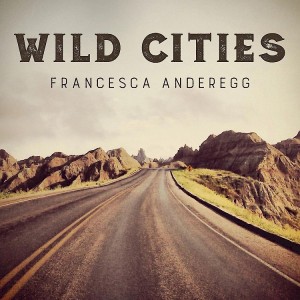Winding through the neon lights of electronic dance music, the dusty panes of Appalachian fiddling, and the fluid shadows of post-Romanticism, Francesca Anderegg delivers a dynamic and adventurous look into the contemporary life of classical music. In her latest album, Wild Cities, Anderegg teams up with pianist Brent Funderburk to feature five young American composers, each influenced by John Adams’ compositional style of minimalism. Inspired by Allen Ginsberg’s poem, “After Dead Souls,” Anderegg takes us on a journey to the “wild city” via open roads of virtuosity, and weaving landscapes of transnational, musical traditions.
The album opens with Ryan Francis’ “Remix.” With no time for delay, Anderegg begins the album with total confidence and precision. The initial rhythm, even and repetitive, contains an assured vibrancy. Anderegg treats each rhythmic value with judicious equality, and employs even bow changes; this approach maintains a clean aesthetic yet still augments the phrases’ underlying tensions. While each note carries a life within itself, Anderegg shapes a 2-dimensional soundscape that nobly sits in static excitement. Funderburk’s entrance is somehow both calamitous and propelling. Though the rhythms seem disjunct and competing, the musicians’ perfect ensemble and tranquil confidence balance the composition’s structural irregularities. Anderegg and Funderburk’s cool yet involved approaches allow the listener to relish in the work’s off-kilter, yet directional rhythm.
Moving from Francis’ EDM-inspired jaunt, Anderegg and Funderburk gracefully dive into the pulling tides of Hannah Lash’s “Adjoining.” Beginning with seamless legato, Anderegg shapes the longing phrases with intent vibrato. No moment goes unaccounted for, and no moment is exactly as the last. Anderegg sensitively conveys the subtle and ever changing nuances key to the piece’s emotive complexity. In her exploration into the piece’s stratosphere, Anderegg balances between sweet delicacy and cathartic intensity. Anderegg and Funderburk’s musical communication is like warm taffy. The duo skillfully dances between leading and supporting roles, always aware of a shared direction. When Anderegg has the lyrical melodies, Funderburk’s accompanying rhythms weigh and push the phrase’s direction. When Funderburk takes the melody, Anderegg’s assured bow control and expressive vibrato create a hovering mist for the piano to twirl over.
Finishing “Adjoining” with a trailing harmonic, Anderegg and Funderburk step into Clint Needham’s Midwest-inspired aesthetic: “On the Road.” Based on Jack Keroak’s legendary Beat classic, the first movement, “Nothing Behind Me,” explores a barren sound world—similar perhaps to that of Kerouac as he passes through the dry flatlands of Nebraska. The movement, divided into three sections, repeats a gradual transition from placid, straight-line travel to effervescent evaporation. The beginnings of the three sections demonstrate a sonic emptiness, only to be broken by the piano’s simple and strolling, rhythmic yellow dashes. The play between the piano’s forward tribute to time and the violin’s warm and sleepy vibrato gives a sense of car travel. The violin’s long-reaching tones combined with the piano’s calm, pulsing chords steadily and smoothly move the listener through the expansive space. In line with John Adams’ approach to minimalism, the movement explores how motion can exist in seemingly static, or gradually changing soundscapes.
Venturing to the southeast, Anderegg pays a visit to the old-time, Appalachian fiddling tradition. Ted Hearne’s “Nobody’s” mixes the plain and sinewy, round peak style, with extended techniques illustrative of electronics. Though the two styles are seemingly incompatible, Hearne’s fuses them into something that feels astonishingly primordial. The extended techniques augment the fiddling’s aggression, pushing the aesthetic’s temporal placement past that of early, recorded fiddling, and into an almost barbaric timeframe. Hearne’s sonic fusion between technology and tradition contains an ancient, timeless quality. Using an earthbound sense of pulse, Anderegg expertly navigates through this anachronistic sound world. Though the piece’s initial rhythms fluctuate, Anderegg never loses sight of the pulse’s lead line. As the piece gradually becomes more rhythmically consistent, Anderegg seems to wildly jam, dancing thunder upon her pulse’s indestructible foundation.
Reinaldo Moya’s four-movement “Imagined Archipelagos,” explores an optimistic, often times impressionistic space between Venezuelan folk music and minimalism. The second movement, “The Island with the Imaginary Moons,” is particularly breathtaking; like swimming through a dream, the movement paints a world in constant motion. Against this minimalistic backdrop, Anderegg shapes the movement’s sweeping phrases through expressive, nuanced vibrato; yet with long and even bow strokes, she maintains the piece’s subdued twilight. Anderegg and Funderburk gracefully glide, shifting between moments of rising breath and deep tones of sighing undercurrents. The last movement, “The Island of the Imagined Birds,” seems to pay homage to Bach’s classical allegro before diverging into irregular rhythms and ensemble. As the movement builds, Anderegg marches into, what seems to be, a passage inspired by the first movement of Mendelssohn’s Violin Concerto. Though the movement explores contemporary, asymmetrical rhythms, nontraditional voice leading and disjunct ensemble, it connects to the Classical and Romantic periods. In a growing body of compositions that rejects the past, Moya seems to lense his future in rich, musical tradition.
“Wild Cities” offers an optimistic look into the frontiers of music composition. While I enjoyed reading about each piece’s history and purpose, the music’s emotional expressivity stood on its own. With influences ranging from EDM to round peak fiddling, the album embraces an eclectic sort of musical traditions, calling for an era of historical and cultural fusion.

2,894 Comments
Cool stuff you have got and you keep update all of us. hoki 22
What is an outstanding post! “I’ll be back” (to read more of your content). Thanks for the nudge! a course in miracles online
I needed to thank you for this phenomenal read!! I unquestionably adored each and every piece of it. I have you bookmarked your site to look at the new stuff you post. telo per piscina
I am really enjoying reading your well written articles. It looks like you spend a lot of effort and time on your blog. I have bookmarked it and I am looking forward to reading new articles. Keep up the good work. ایمپلنت ارزان تهران با دکتر هومن هوشنگی